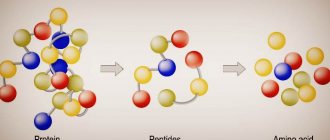Bcaa amino acids are a complex of leucine, isoleucine and valine. This is a key material for building muscle mass. Muscles contain 35% of essential amino acids, they are directly responsible for the processes of recovery and anabolism, and also have an anti-catabolic effect. Substances are not synthesized in the body; a person receives them together with special supplements and food.
The main difference between bcaa and the 17 other amino acids is metabolism directly in the muscles. Substances are the main “fuel” for muscle mass, they help improve athletic performance and improve overall health. Reception is absolutely safe for humans. Bcaa amino acids are the most common and popular type of sports nutrition.
Content
- 1 BCAA Amino acids 1.1 BCAA in food
- 2.1 Research
- 3.1 BCAA as an energy substrate
BCAA Amino Acids[edit | edit code]
| What are BCAA | |
| BCAA consists of three amino acids that have a branched molecular configuration: valine, leucine and isoleucine. They are found in meat, fish, eggs, milk and other protein products. | |
| Action of BCAA | |
| BCAAs can be used as an energy source during aerobic exercise, especially when muscle glycogen is depleted. Thus, these supplements may have a protein-sparing effect. A 1994 study from the University of Guelph, Ontario, Canada, suggests that taking BCAAs during and after exercise may reduce muscle breakdown. A study from the University of Tasmania, Australia, concluded that BCAAs may speed up recovery. However, it is still unclear whether long-term use of BCAA can improve performance. A study of long-distance cyclists conducted by the University of Virginia, USA, found that BCAA supplements taken before and during a 100-kilometer cycling exercise test did not improve endurance performance compared to drinking a carbohydrate drink. There has been no research in strength athletes, but one study in ski mountaineers found that BCAA had no effect on muscle mass or strength. | |
| Do you need BCAA's? | |
| The benefits of BCAA are limited. They probably won't improve your endurance, but at doses of 6-15g (which were used in the University of Virginia studies) they may help improve recovery during periods of intense training by reducing muscle protein breakdown and post-exertional injuries. BCAAs are found in sufficient amounts in most protein supplements (especially whey protein supplements) and meal replacement products, so if you're already taking one of these products, there's probably no point in taking them. | |
| Side effects | |
| BCAAs are relatively safe as they are found in normal daily dietary protein. Excessive consumption may reduce the body's absorption of other amino acids. |
BCAA in bodybuilding[edit | edit code]
Appearance when dissolved
Claimed effects of BCAA amino acids in bodybuilding:
- Protecting muscles from destruction
- Increased lean muscle mass
(controversial) - Reduced body fat percentage
(not proven) - Increased strength
(not proven) - Increases the effectiveness of sports nutrition
(partially justified for incomplete protein)
The role of BCAA in the body:
- Substrate for muscle protein synthesis
- Substrate for energy production
- Precursors for the synthesis of other amino acids, especially alanine and glutamine
- BCAA Metabolic Modulators Stimulate Muscle Protein Synthesis by Activating PI3K
- Stimulates muscle protein synthesis by activating mTOR
BCAAs perform many important functions and can be used when gaining muscle mass, losing weight, working on relief, and aerobic training. However, for quality and economic reasons, whey protein is preferable as a source of BCA.
Research[edit | edit code]
Critical review (Boris Tsatsouline)
Main article:
Research on the effects of BCAA
BCAA amino acids have a weaker evidence base compared to protein and creatine. Scientific works that experimentally confirm the role of BCAAs in sports:
- Yoshiharu Shimomura — Exercise Promotes BCAA Catabolism: Effects of BCAA Supplementation on Skeletal Muscle during Exercise
Quote from the conclusion:
These data confirm that fatty acids may be one of the regulators of BCAA metabolism, and also that during exercise the body experiences a higher need for BCAA amino acids. Moreover, supplementation of these amino acids immediately before and after exercise results in decreased muscle breakdown and increased muscle protein synthesis[4]
- Elisabet Børsheim — Essential amino acids and muscle protein recovery from resistance exercise
Quote from the conclusion:
Essential amino acids accelerate the synthesis of muscle protein, but the introduction of non-essential amino acids for these purposes, as the experiment showed, is not necessary. The greater the dose of administered BCAA amino acids, the greater the anabolic response was obtained.
- Jim Stoppani — Consuming a supplement containing branched-chain amino acids during a resistance-training program increases lean mass, muscle strength and fat loss
Quote from the report:
BCAA supplementation during 8 weeks of strength training resulted in decreased body fat, increased lean muscle mass, and increased bench press and squat strength.
Despite the impressive evidence base, many studies highlight vulnerabilities in protocols and statistics, which may indicate the authors’ interest in obtaining positive results.[5]
Criticism[edit | edit code]
Main article:
Criticism of the effectiveness of BCAA
Based on the analysis of a wide range of studies, it can be summarized that it is preferable to use protein instead of BCAA. There are also serious concerns about the quality of cheap BCAA supplements that may be made from food waste. Many studies can be falsified, and the effects claimed by the manufacturer are not true.
How to take BCAA amino acids, reviews, composition, instructions, differences
Return to blog
26.11.2014
Buy BCAA amino acids, compare prices, find out the cost
In this video, Kirill Kolyaskin and Alexey Koshelev will tell you: - what kind of supplement is bca - why are BCAA amino acids needed - how to take BCAA - what is included in BCAA - their own experience and reviews from taking bca while cutting - how much do you need to drink BCAA for them to really work - release forms and the difference between them - produced bcaa formulas and proportions of essential amino acids (leucine, isoleucine, valine) - the best bcaa, how to choose them
Bcaa is understood as a complex of three essential amino acids, namely: Leucine, Isoleucine, Valine. They cannot be independently synthesized by our body and can only come from outside, along with food or sports supplements. More than a third of the muscles in our body consist of these three amino acids.
- Increases your athletic performance, such as: strength, endurance, speed of recovery after heavy physical activity.
- Helps improve health.
- Protects your muscles from destruction, suppresses catabolism during intense exercise.
- Accelerate the gain of clean, lean muscle mass.
- Helps reduce body fat percentage.
- They are a source of energy during aerobic exercise.
The optimal serving per serving is from 5 g to 15 g, depending on your weight. If you have capsules or tablets, look at the composition per serving and divide the required number of grams by the protein content in one serving recommended by the manufacturer. Multiply the resulting number by the number of capsules/tablets in one serving from the manufacturer. This will give you the number of capsules/tablets you need to take at one time. Remember that it is better to drink in small portions more times than to drink the daily norm at once.
The most important BCAA intake for weight loss is immediately after an intense workout. To enhance the effect, it would be optimal to take one serving at the beginning of your workout. If you exercise for more than 1.5 hours, you should take another serving in the middle of your workout. Another important technique is in the morning immediately after sleep to prevent catabolic processes.
For accelerated recovery, we recommend taking several servings (from 2 to 5) throughout the day, between main meals. It is important to drink BCAA not only on training days, but also on rest days.
For gaining muscle mass, the very fact of daily intake of leucine, isoleucine and valine in sufficient quantities is important. The number of doses will depend on your body weight, daily diet and other sports supplements taken during the day. Remember that to increase muscle mass per day you need to get at least 2 g of protein per 1 kg of your own weight. When gaining mass, it is not so important whether you take amino acids on an empty stomach or with meals.
BCAA comes in powder, capsules, tablets, and liquid concentrates. Less commonly in portioned plastic ampoules and bottles diluted with water. The rate of absorption of concentrated and powder BCAA diluted in water is about 15 minutes. Capsule and tablet forms are absorbed in approximately 30 minutes.
Classic BCAA consist of Leucine, Isoleucine, Valine, but recently you can often see the addition of other amino acids to the composition. Such as: glutamine, beta-alanine, citrulline, etc. The addition of these amino acids, according to manufacturers, is due to better absorption of the “main trinity”. Powdered and concentrated supplements often contain added flavoring agents and sweeteners, as pure BCAAs have an unpleasant bitter taste.
BCAA amino acids are found in every type of protein. Therefore, they cause no more harm than regular food.
The most important thing when choosing is the amount of BCAA themselves in the package. The next factor is ease of carrying and consumption (some people like capsules, some like powder, some like concentrate). Next comes the choice of flavor or tasteless additives. The percentage ratio of leucine, isoleucine, valine matters (it is according to this logic that they write on the packaging 2:1:1, 4:1:1, 3:1:2, 8:1:1, etc.), the most popular ratio is 2:1 :1. Another difference is in the composition, namely whether additional amino acids are added. If you plan to drink mainly during training, then you should take it with additional amino acids.
Protein in sports nutrition is a nutritional supplement based on protein. Protein, entering our body, after some time is broken down into amino acids. Some of these amino acids (leucine, isoleucine, valine) are called BCAA. Therefore, BCAAs are found in foods containing protein, in every type of protein and in all complex amino acids. Due to the high importance of these amino acids, manufacturers produce supplements based on leucine, isoleucine and valine.
To lose weight, athletes often combine BCAA intake with L-carnitine and complex fat burners.
Sports supplements such as protein, creatine, gainer, glutamine, arginine, complex amino acids, testosterone boosters, complex sports vitamins, fatty acids, pre-workout and post-workout complexes are also well suited for weight gain. However, for better absorption, taking these sports supplements should be divided in time with a difference of 30 minutes after consuming BCAA.
Ultimate Nutrition BCAA 12000 flavored powder Optimum Nutrition BCAA 1000 Optimum Nutrition BCAA 5000 Dymatize Nutrition BCAA 2200 MusclePharm BCAA 3:1:2 BSN Amino X Maxler Amino X-Fusion SAN BCAA Pro Reloaded Olimp BCAA Xplode Powder Scitec Nutrition BCAA Xpress
Order BCAA with delivery or pickup
Mechanisms of action of BCAA[edit | edit code]
Let's take a closer look at the points listed above, with a thorough analysis of biochemical processes and links to research and scientific literature, to give a complete picture of the role of BCAA in sports.
BCAA as an energy substrate[edit | edit code]
Exercise increases the oxidation of BCAA [6] in order to maintain energy homeostasis by converting it into a readily available energy source, glucose. Research shows that during and after exercise in athletes, the concentration of BCAA (especially leucine) decreases; immediately after this, metabolic processes are activated that are aimed at normalizing the concentration of BCAA, that is, muscle proteins begin to break down, as the main sources for replenishing the BCAA amino acid pool. Taking additional BCAAs in the form of supplements can restore their concentration and stop the process of muscle breakdown.
In addition, recently scientists have paid special attention to the role of leucine as a source of ATP (the main energy substrate of the body). [7] The oxidation of leucine in muscle produces even more ATP molecules than the same amount of glucose. And given that the oxidation of leucine and glucose follows different paths, the athlete receives 2 powerful sources of ATP at once, that is, he restores his strength much faster.
Muscle protein synthesis[edit | edit code]
As mentioned above, BCAAs make up a third of all amino acids in muscle proteins, so they can be considered the main building material of muscles. Protein can only be synthesized if free amino acids are available, otherwise growth stops. At rest, to replenish the need for amino acids, it is enough to take protein, which is gradually absorbed from the intestines and completely satisfies metabolic needs, however, during and immediately after training, the need for amino acids increases sharply, and the amino acid pool is depleted, so there is a need for large supplies of amino acids. Thus, by taking BCAA in the form of sports nutrition, the athlete creates favorable conditions for restoring the amino acid pool and building new muscle fibers immediately after training.
BCAA as glutamine precursors[edit | edit code]
BCAA as sources of glutamine
Glutamine plays an important role in muscle growth. Glutamine is found in large quantities in muscles and other tissues, plays a regulatory role in the synthesis of all types of protein in the body, shifts the nitrogen balance to the anabolic side, increases the volume of muscle cells and increases the production of growth hormone. [8]
The increased consumption of glutamine during exercise can be covered by BCAAs, which can be converted into it directly in the muscles. [9]
Stimulation of insulin secretion, PI3K and protein synthesis[edit | edit code]
One pathway that speeds up protein synthesis (i.e. muscle growth) is the phosphatodyl-inositol 3-kinase (PI3K) pathway. PI3K regulates glucose consumption and accelerates the transport of amino acids into cells. Insulin carries out its anabolic effect precisely due to PI3K.
BCAA (leucine) can enhance insulin secretion and directly activate PI3K, thus triggering anabolism even in the absence of insulin. [10] Consuming carbohydrates and BCAA after exercise leads to a synergistic rise in insulin levels, increased cellular uptake of nutrients, and accelerated muscle growth.
Activation of mTOR accelerates protein synthesis[edit | edit code]
Activation of mTOR
mTOR
from English mammalian target of rapamycin (mTOR) is a protein that regulates cell growth and division, as well as new protein synthesis. mTOR functions as an energy sensor that is activated when ATP levels are high and blocked when ATP levels are low.
The most energy-consuming process in a cell is protein synthesis, so it requires large amounts of ATP, and in addition, building material is needed - amino acids, that is, BCAA. Research shows that the intensity of anabolic processes is regulated by mTOR, which triggers protein synthesis when there is sufficient ATP and BCAA. [11] Scientists have determined that leucine plays a key role in mTOR activation [12]
BCAA and fat burning[edit | edit code]
Taking BCAA stimulates the expression of genes for the hormone leptin in adipocytes (fat cells), via the mTOR-mediated pathway. [13] Leptin is a very complex hormone that regulates many metabolic processes, such as body weight, appetite, and fat consumption and storage.
The secretion of leptin is related to the amount of body fat, the higher the percentage of body fat, the higher the secretion of leptin and vice versa. When you go through a fat-burning cycle and diet, the amount of leptin decreases, which leads to an increase in appetite and economization of metabolic processes in order to restore or maintain energy reserves of fat. That is why some athletes can significantly reduce the calorie intake and increase the load, but body weight will not change, as the body tries to maintain homeostasis. For this reason, sometimes it is necessary to greatly restrict the diet in order to shift homeostasis from the so-called control point.
BCAA, namely leucine, helps move the control point and increase leptin secretion. BCAAs seem to deceive the body, making it think that high-calorie food is entering the body. BCAAs can suppress appetite, increase calorie expenditure by burning fat, increase metabolism, and most importantly protect muscles from destruction.
Bcaa amino acids: bodybuilding
Every bodybuilder receives muscle microtrauma during training. Athletes need complete recovery of muscles, joints and ligaments after exercise. Testosterone, insulin and other hormones, combined with a positive nitrogen balance, provide the famous supercompensation effect. Its essence is to increase the number of cells and muscle volume to withstand heavy loads.
A positive nitrogen balance and hormones are necessary for every athlete. It is the essential amino acids that play a key role in the synthesis of these substances. Sports nutrition has another important property - blocking cortisol. This is a hormone that causes catabolic processes in muscles. Bcaas reduce cortisol secretion and protect existing muscle tissue from breakdown due to nutritional deficiencies and heavy exercise.
When to take BCAA[edit | edit code]
The effect of taking BCAA on body weight, muscle volume and fat percentage for 8 weeks in the amount of 14 g before/during training + 14 g after training
When gaining muscle mass
The most appropriate time to take BCAA is in the morning, as well as before, during and immediately after training. You can prepare an energy drink before training by dissolving a portion of amino acids and a few tablespoons of sugar in water. This will ensure a constant flow of fluid, carbohydrates and amino acids into the blood throughout the entire workout. As mentioned above, the body especially needs BCAA during and after training, this is when BCAA are most effective, so they need to be taken 30-40 minutes before starting, and immediately after training, as well as during it, if this soluble form. It is also advisable to take a portion of amino acids immediately after sleep to suppress morning catabolism. Studies have shown that BCAAs are effective even when mixed with a protein shake.
There is an opinion that there is no point in taking BCAA, like other amino acids and proteins, before training, since during exercise the body reduces digestive function, however, it remains. That is why marathon runners consume solutions of amino acids and isotonic drinks directly while running.
When losing weight and working on relief
BCAA should be taken in the same way as described above: in the morning on an empty stomach, before training and immediately after training, soluble forms - during training. In addition, when losing weight, you can take BCAA in between meals in order to suppress catabolism, appetite and preserve muscles, but it is more profitable to use protein for these purposes.
How much to take BCAA[edit | edit code]
Popular sources of BCAA amino acids
Most professional trainers agree that for every kilogram of body weight, an athlete should receive about 33 mg/kg of leucine per workout. The optimal single dose of BCAA is 4-8 grams, both when losing weight and when gaining muscle mass. The frequency of administration is 1-3 times a day. Smaller doses of BCAA are also effective, but they will no longer fully cover the body's needs. Many manufacturers cheat and produce BCAA in small doses, although the price remains high, so always look on the back of the package for the number of servings and the size of one dose of BCAA. The duration of taking BCAA is not limited, breaks and cycling are not required. There are quite a lot of sources on the Internet that advise taking BCAA in increased dosages (15-20 grams per dose), arguing that the body needs an increased amount of amino acids after physical activity. However, at the moment there is no strong evidence base to support this advice. Also, there is no information on how well BCAA are absorbed in the body when consumed in higher dosages[14].
The dosage of BCAAs is indicated without taking into account their content in protein supplements and products (any protein contains these amino acids, but the aspect of additional intake is discussed, provided that a sufficient amount of protein is received per day).
Bcaa amino acids: intake
The optimal dose has been identified, suitable for 95% of athletes; it is 4-8 g per day. This method of administration is suitable both during the period of fat burning and during active muscle gain. It is not recommended to consume food in smaller quantities, as this will not lead to a complete restoration of the body's needs. Bcaa amino acids should be taken no more than 3 times a day.
A few more key admission rules:
- Taking amino acids separately will not give the desired effect; the substances are used only together.
- Taking amino acids in combination with other supplements will also not give the desired effect.
- It is possible to use bcaa in combination with glutamine, which plays an important role in building muscle mass. Other effects include increased endurance and improved secretion of most hormones.
Our catalog contains amino acids from more than 20 world-famous brands. Experienced specialists and professional athletes provide assistance in choosing the right nutrition. Contact them for advice, make a decision and let us know right away! Call today!
Production methods and health hazards[edit | edit code]
Amino acid production occurs in four main ways:
- Extraction from hydrolyzate
- Biosynthesis or biofermentation (amino acids are produced by mutant strains of bacteria)
- Chemical synthesis
- Enzymatic synthesis (synthesis using purified enzymes)
Chemical and enzymatic synthesis for BCAA is practically not used. Bacterial biosynthesis is widely used in food products.
Currently, BCAA's for food use are produced mainly by biofermentation. Leucine, isoleucine and valine are produced by E. coli and C. glutamicum strains through the pyruvic and aspartic acid pathway. [15] Thus, isoleucine and valine are actually by-products of the synthesis.
The biofermentation method increases the cost of amino acids by 300-400% compared to chemical hydrolysis.[16]
Poor quality raw materials.
In the process of producing food amino acids, plant sources (soybeans, grains) and animal sources (milk proteins) are used. Most often, manufacturers do not indicate the sources of raw materials. Electrodialysis and several other methods can be used to obtain amino acid hydrolyzate from food and other biological wastes, including human hair, fish, feathers, blood, meat waste, etc.[17][18][19] The use of low-quality raw materials can significantly reduce the cost of the output product. There is evidence that most Chinese BCAAs are made from waste.[20][21][22]
Extraction.
The production of BCAA by this method begins with the process of protein hydrolysis. Hydrolysis can be done enzymatically or chemically by heating the protein with acids and solvents. Amino acids are then extracted from the resulting hydrolyzate. For this purpose, centrifugation, absorption, ion exchange filtration, recrystallization, precipitation, etc. are used.[23][24][25] The fraction of amino acids with side chains (the so-called leucine fraction) is separated from soy protein and other hydrolysates quite easily because they have similar molecular size and charge.[26]
Harm to health
could be for two main reasons:
- The use of low-quality raw materials and extraction does not exclude the content of toxic compounds and contaminants in the final product.
- The biofermentation method does not exclude the content of D-isomers in the final product, the biological effect of which may be potentially undesirable.
Links[edit | edit code]
- "Exercise Promotes BCAA Catabolism: Effects of BCAA Supplementation on Skeletal Muscle during Exercise." J. Nutr. 134(6):1583S-1587S. 2004. Retrieved March 22, 2011
- Layman, 2003
- BJSM reviews: AZ of nutritional supplements: dietary supplements, sports nutrition foods and ergogenic aids for health and performance Part 4. Burke LM et al. Br J Sports Med. 2009 Dec;43(14):1088-90. doi: 10.1136/bjsm.2009.068643. www.ncbi.nlm.nih.gov/pubmed/19955167
- That is, to muscle growth
- https://jissn.biomedcentral.com/articles/10.1186/s12970-016-0128-9
- Shirmomura et al., 2004
- Freund and Hanani (2002)
- Houston (2001), VanAcker et al. (1999) and Haussinger et al. (1993)
- Holecek, 2002
- Nishitani et al. 2002 and Layman, 2002
- Dennis et al., 2001
- Anthony et al. 2001 & Lynch et al. 2002
- Meijer and Dubbelhuis, 2003
- https://iron-set.com/sportivnye-dobavki/kak-pit-bcaa
- Biotechnology of Food and Feed Additives
- https://www.kagedmuscle.com/blogs/science/113500163-know-your-bcaa-4-differences-you-didnt-know
- Sandeaux J. et al. Extraction of amino acids from protein hydrolysates by electrodialysis // Journal of Chemical Technology and Biotechnology. – 1998. – T. 71. – No. 3. – pp. 267-273.
- https://www.sciencedirect.com/science/article/pii/S1004954108601056
- https://www.vrg.org/blog/2011/03/16/leucine-isoleucine-and-valine-may-be-derived-from-duck-feathers-or-human-hair-vegetable-based-versions- available/
- https://truenutrition.com/blog/bcaa-dark-side/
- https://www.vrg.org/blog/2011/03/16/leucine-isoleucine-and-valine-may-be-derived-from-duck-feathers-or-human-hair-vegetable-based-versions- available/
- https://blog.nutrabio.com/2015/08/18/the-truth-about-animal-vs-plant-based-bcaas/
- Martinez-Maqueda D. et al. Extraction/fractionation techniques for proteins and peptides and protein digestion //Proteomics in Foods. – Springer US, 2013. – pp. 21-50.
- https://www.fda.gov/ohrms/DOCKETS/ac/01/briefing/3796s1_03%20TSEAC-Rexim-Degussa/sld015.htm
- https://link.springer.com/book/10.1007/978-1-4020-6674-0
- Hongo C. et al. The preparation of pure L‐leucine. Separation of L-leucine and L-isoleucine // Journal of Chemical Technology and Biotechnology. – 1979. – T. 29. – No. 3. – pp. 145-148.
Why don't BCAAs work? Myths about the effectiveness of amino acids. Research Review
Greetings, friends! My name is Tsatsulin Boris, you are on the video channel of the cmt scientific approach project and today I want to continue the conversation about BCA amino acids, which are actively used by athletes and are currently the second most popular supplement after protein on the Russian market. In one of my past videos, I talked briefly about why BCAA is not the best choice.
And today for you I have prepared the most, dare I say it, large-scale analysis of research on the effectiveness of amino acids. Trainers, nutritionists, and specialists shake their heads as they talk about the powerful effects of these supplements. Either they really believe in their effectiveness, or they are engaged in selling these products.
Today you will finally find out what real science and real facts say about the effectiveness of these supplements.
What are BCAA's?
BCAA is used by different people for different purposes (bodybuilders and other athletes have one goal, track and field athletes have another, some are trying to gain mass, while others are trying to burn as much fat as possible). They help you recover, they make your muscles huge and meaty, and without them you are lost and catabolic.
Branched chain amino acids (BCAA) are so named because of their branched chemical structure consisting of three essential amino acids: leucine, isoleucine and valine. BCAA is one of the most popular supplements on the market. The popularity of BCAA is partly achieved thanks to leucine, which, according to one study, influences [1] protein synthesis through stimulation of a biochemical sensor (rapamycin kinase) - the purpose of which is the appearance of rapamycin in cells. (TOR kinase - stimulates the production of proteins and fats and ensures entry into the cell enough energy). And protein synthesis is muscle growth.
So! Here is a three-week study by Mourier (1997)[9], which is often cited by campaigns selling BCAA. It examined the effects of 52g BCAA on the body composition of wrestlers. And of course, the wrestlers had calorie restrictions.
There is research showing that consuming BCAAs leads to muscle growth and the prevention of muscle fiber breakdown, but the question that remains unexplored is whether the same effect will hold true when consuming whole foods? Do you understand?
Dr. Lane Norton
I would like to express my gratitude for your help in preparing some materials from the video:
https://vk.com/id34044265
https://vk.com/id112872366
https://www.facebook.com/lanka.smile
Guys! Thank you!
Sources:
1. https://www.ncbi.nlm.nih.gov/pubmed/16365087 2. https://www.ncbi.nlm.nih.gov/pubmed/16365100 3. https://www.ncbi.nlm. nih.gov/pubmed/18577773 4. https://www.ncbi.nlm.nih.gov/pubmed/9059905 5. https://www.ncbi.nlm.nih.gov/pubmed/22569039 6. https:/ /www.ncbi.nlm.nih.gov/pubmed/16365096 7. https://www.ncbi.nlm.nih.gov/pmc/articles/PMC2901380/ 8. https://www.ncbi.nlm.nih. gov/pubmed/15253675 9. https://www.ncbi.nlm.nih.gov/pubmed/9059905 10. https://www.ncbi.nlm.nih.gov/pubmed/17095924 11. https://www .ncbi.nlm.nih.gov/pmc/articles/PMC3313152/ 12. https://alanaragon.com/researchreview 13. https://www.ncbi.nlm.nih.gov/pubmed/2647435 14. https:/ /www.ncbi.nlm.nih.gov/pubmed/8306557 15. https://www.ncbi.nlm.nih.gov/pubmed/16365087 16. https://www.ncbi.nlm.nih.gov/pubmed /10198297 17. https://www.ncbi.nlm.nih.gov/pubmed/14583440 18. https://www.ncbi.nlm.nih.gov/pubmed/10198297 19. https://ajpendo.physiology. org/content/ajpendo/282/5/Efull.pdf 20. https://www.ncbi.nlm.nih.gov/pubmed/11306673 21. https://www.bodyrecomposition.com/the-protein-book 22 https://www.ncbi.nlm.nih.gov/pubmed/10331398 23. https://www.ncbi.nlm.nih.gov/pmc/articles/PMC2129150/ 24. https://www.ncbi. nlm.nih.gov/pubmed/2647435 25. https://www.ncbi.nlm.nih.gov/pubmed/21410984 26. https://www.ncbi.nlm.nih.gov/pubmed/11306673 27. https ://www.ncbi.nlm.nih.gov/pubmed/15572657 28. https://www.ncbi.nlm.nih.gov/pubmed/15572657 29. https://www.ncbi.nlm.nih.gov /pubmed/21410865 30. https://www.ncbi.nlm.nih.gov/pubmed/17135624 31. https://www.ncbi.nlm.nih.gov/pubmed/20110810 32. https://www. ncbi.nlm.nih.gov/pubmed/19385022 33. https://www.nutritionexpress.com/article+index/protein/bcaas/showarticle.aspx?id=7
Based on materials.











